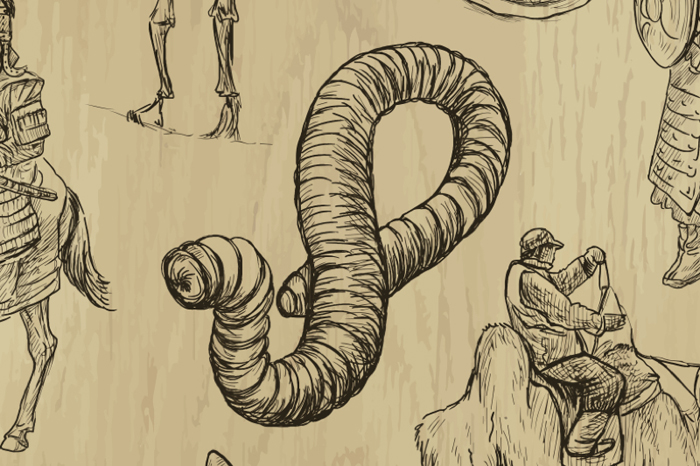Mongolian Death Worm: Elusive Legend of the Gobi Desert

It sounds like a fantastic, lethal creature that might be found in a 1950s pulp science-fiction novel (or sci-fi television movie), but some people believe that a large, deadly worm-like creature called the Mongolian Death Worm exists in the Gobi desert.
According to British biologist Karl Shuker in his book "The Unexplained: An Illustrated Guide to the World's Paranormal Mysteries" (2002, Metro Books) "One of the world's most sensational creatures may be concealed amid the sands of the southern Gobi desert. ... It is said to resemble a large fat worm, up to 1 meter (3 feet) long and dark red in color, with spike-like projections at both ends. It spends much of its time hidden beneath the desert sands, but whenever one is spotted lying on the surface it is scrupulously avoided by the locals."
According to legend, the dreaded Mongolian Death Worm — which local people call olgoi-khorkhoi or loosely translated, "large intestine worm" — has lived up to its name. It can kill in several fearsome ways, including spitting a stream of corrosive venom that is lethal to anything it hits, and if that doesn't do the trick it is said to be able to electrocute its victims from a distance. Rarely seen and never photographed, it was mentioned in a 1926 book by paleontologist Roy Chapman Andrews, who didn't believe in the animal's existence but noted that stories of it circulated in Mongolia.
Seeking the death worm
Despite — or perhaps because of — the creature's fearsome name (they don't call it the Mongolian Happiness Worm, after all) many intrepid explorers have set out into the Gobi desert seeking the beast. Numerous organized expeditions and searches have been made over the years, by both independent researchers and in conjunction with television shows. Despite extensive searches, eyewitness interviews, and even setting traps for the beast, all have come back empty-handed.
Many of those who believe in the creature acknowledge that there is no hard evidence of its existence, but instead believe that legends and stories of them must have some basis in historical truth. The descriptions (mostly second- and third-hand stories) from different places and times are too similar, they believe, to be anything but independent eyewitness reports.
From a folkloric perspective, however, this is simply a sign that legends and stories of the Death Worm have spread throughout the region, as commonly happens through trade and travel. Many people around the world can offer very similar descriptions of dragons, leprechauns, mermaids, and other fantastic (presumably non-existent) creatures — not from personal experience but from hearing about them from others.
So is there a real animal behind the stories and legends? It seems doubtful. Compared to the North American Bigfoot or the Himalayan Yeti — for which there are dozens or hundreds of alleged footprints, photographs, for example — there is virtually no evidence of its existence.
Get the world’s most fascinating discoveries delivered straight to your inbox.
Consider also that no live or dead ones have been found. Every other creature known to exist has left behind a dead body or skeleton. In fact, the Gobi would likely preserve carcasses of the animal, due to the relative lack of predators and hot desert winds that slow decomposition. Inhabitants of the Gobi are aware of the global interest in their mystery monster, as well as offers of rich rewards for one of the creatures, live or dead, and if one was found it would surely come to light.
Legends and evidence
A zoological perspective may help us sort fact from fiction in the legend of the Mongolian Death Worm. First of all, we should not be misled by the "worm" in its name; that's an English translation. The creature — if it exists in the inhospitable Gobi desert — could not be a soft, fleshy worm; instead, it is likely a type of snake or legless lizard. This also means it would be a vertebrate animal with a spine that would presumably be found by searchers.
A variety of explanations have been offered for the animal, including perhaps a misidentified or new species of snake. The consensus among researchers such as Shuker and author Richard Freeman is that the Mongolian Death Worm likely does not exist, and the belief is instead based upon sightings of either a type of limbless reptile known as worm lizard (which resembles a large worm, burrows underground and can reach several feet in length), or a type of sand boa snake.
Of course, not all the characteristics of the worm lizard or sand boa are a perfect match for the Death Worm: for example terrestrial snakes can't deliver lethal electric shocks (the way that electric eels — which are actually fish, not eels — for example, can). For that matter, several venomous snakes (primarily cobras and vipers) can spit poison, which, although not acidic, can certainly cause harm and blindness. Yet these reputed characteristics are based not on hard data but myths and stories (some accounts of the Death Worm even claim that its venomous spittle can corrode metal instantly, which is physically impossible). With allowances made for the exaggeration found in rumor, legend, and folklore, the worm lizard or a sand snake seem likely candidates.
It is of course possible that the Mongolian Death Worms exist (of course there would have to be more than one of them to sustain what biologists call a breeding population, likely tens or hundreds of thousands of them). Perhaps next week, next month, or next year such a bizarre creature will be found and examined by scientists. Until then it seems likely that Roy Chapman Andrews's assessment nearly a century ago was correct: the creature is merely legend.
Benjamin Radford, M.Ed., is deputy editor of Skeptical Inquirer science magazine and author of seven books including Tracking the Chupacabra: The Vampire Beast in Fact, Fiction, and Folklore and Lake Monster Mysteries: Investigating the World's Most Elusive Creatures. His website is www.BenjaminRadford.com.



